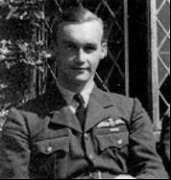Spitfire X4825 near Hartshead Moor.
On 3rd May 1941 this 452 Squadron aircraft and one other of the same squadron were briefed to carry out a small air display over Brighouse, Leeds as part of the town's War Weapons Week. Both pilots were very experienced airmen and had flown operationally in the Battle of Britain. While flying in close formation in the Halifax area the propeller of the other aircraft struck the tail of this aircraft, piloted by the squadron Commanding Officer and part of the aircraft was removed. The pilot of this aircraft lost all fore and aft control of the aircraft and was only able to stop the aircraft loosing too much height by changing the power of his engine and pulling hard on his control column. He turned the aircraft over open country and force landed but crashed through a stone wall further damaging the aircraft and injuring himself. He was later treated for minor injuries in Halifax hospital but returned to Kirton in Lindsey later in the day. The location of where this landing occurred was in the region of Hartshead Moor. The pilot of the other aircraft was able to fly away and land safely, possible back at base but this has yet to be discovered.
Spitfire X4825 was built to contract 19713/39 by Vickers Armstrong's (Supermarine) Ltd at Woolston/Eastleigh and first test flown on 29th November 1940. It
was flown to 9 MU at Cosford on 5th December 1940 and placed into storage. On 24th February 1941 it was flown to 5 MU at Kemble and located in the Robin hangar
site. On 19th April 1941 it was taken on charge by 452 Squadron at Kirton in Lindsey. After the incident near Halifax on 3rd May 1941 it was assessed and deemed
too badly damaged to be repaired, Cat.E/FA damage was recorded and aircraft was struck off charge with just 20.35 hours flying time.
Pilot - S/Ldr Roy Gilbert Dutton DFC and Bar RAF (39072).
Roy Dutton was born in March 1917, he was in the RAF in the years before the outbreak of War having learnt to fly at the Civil Flying School at
Hanworth, He was made acting P/O on 24th August 1936. He was posted to 111 Squadron at Northolt in May 1937 and destroyed two enemy aircraft with
this unit before posting to 145 Squadron in early 1940. His DFC was awarded on 31st May 1940 during the Battle of France. During the Battle of Britain
he shot down many enemy aircraft and was awarded the Bar to the DFC on 20th August 1940. S/Ldr Dutton arrived at Kirton in Lindsey to command 452
Squadron on 13th April 1941 from Tangmere and at the time the unit ORB stated that he had been credited with eighteen enemy aircraft. He then commanded
19 Squadron for a period in mid-1941 before commanding 141 Squadron. Before the end of the War was flying Dakotas, commanding 512 Squadron and 525 Squadron.
As Acting F/Lt he was awarded the DFC, Gazetted on 31st May 1940, the citation reads "In May, 1940, whilst leading a section of a squadron on patrol over
Brussels, Flight Lieutenant Dutton attacked and shot down two Heinkel in aircraft. The next day, when leading a section of a squadron, seven Messerschmitt
fighters were sighted escorting from 50 to 70 enemy bombers. The leader of the formation attacked the bombers and Flight Lieutenant Dutton, realising the
danger to the formation, ordered two aircraft of his own section also to attack the bombers whilst he climbed and engaged the Messerschmitts until the
attack on the bombers was completed. He then dived away, and flying west sighted and shot down a Heinkel in with his remaining ammunition. Flight Lieutenant
Dutton has displayed initiative, gallantry and a complete disregard for his own safety."
He was awarded the Bar to the DFC, Gazetted on 20th August 1940, the citation reads.. "This officer has led patrols with conspicuous success
and has personally destroyed at least twelve enemy aircraft. He has displayed splendid qualities of leadership and courage, with a complete disregard for his own safety."
He commanded the "Rhine" airborne droppings and was awarded the Distinguished Service Order as Acting W/C on 8th June 1945 when commanding 512 Squadron, the citation reads..
"This officer was detailed to lead the glider train comprising well over 400 tug and glider combinations which conveyed members of the airborne division concerned to a point between
Weser and Emmerich in March. 1945. Keenly aware of the responsibility entrusted to him. W/C Dutton led this great force with skill and good judgment to the battle area. First
to reach the zone, his tug glider combination was subjected to heavy fire, but he flew straight and steady to the landing zone several miles behind the enemy's lines. Only when sure that
the glider could reach the objective would be give the order to release. This officer displayed skill, courage and devotion to duty of the highest order."
